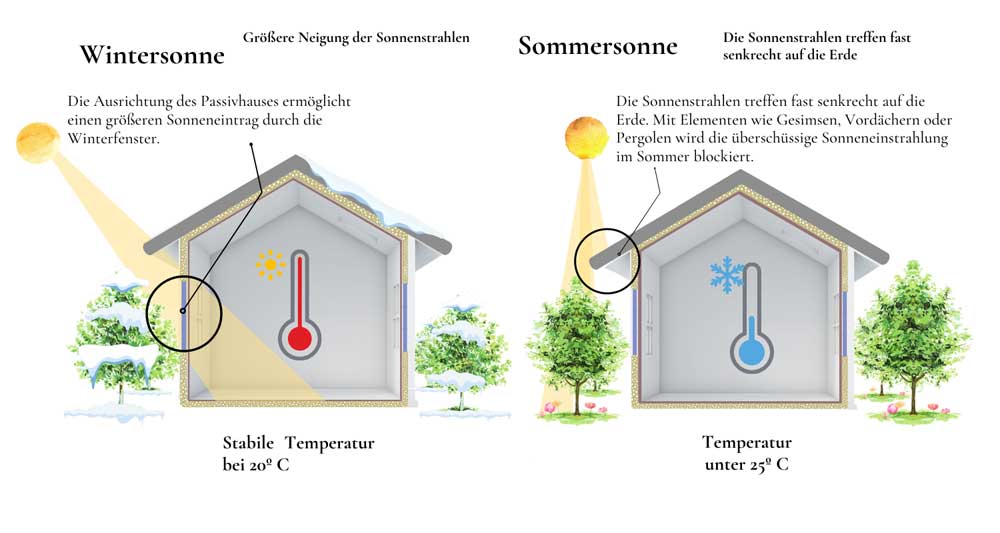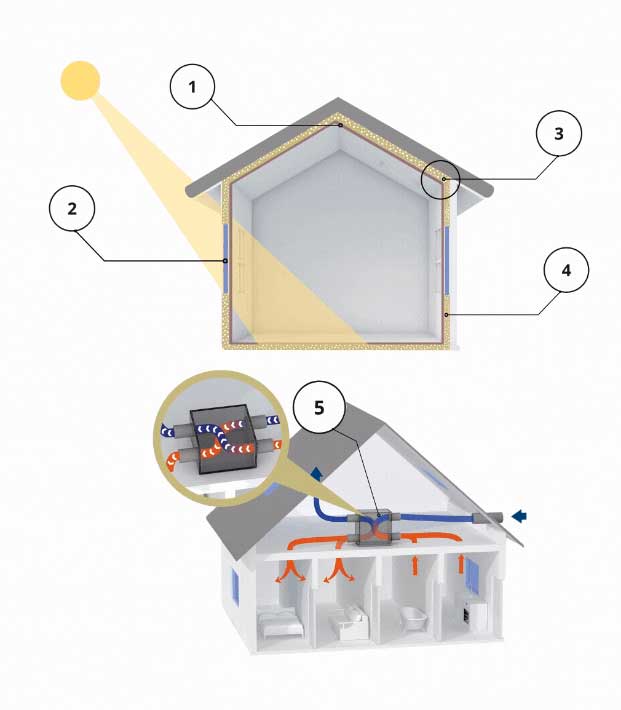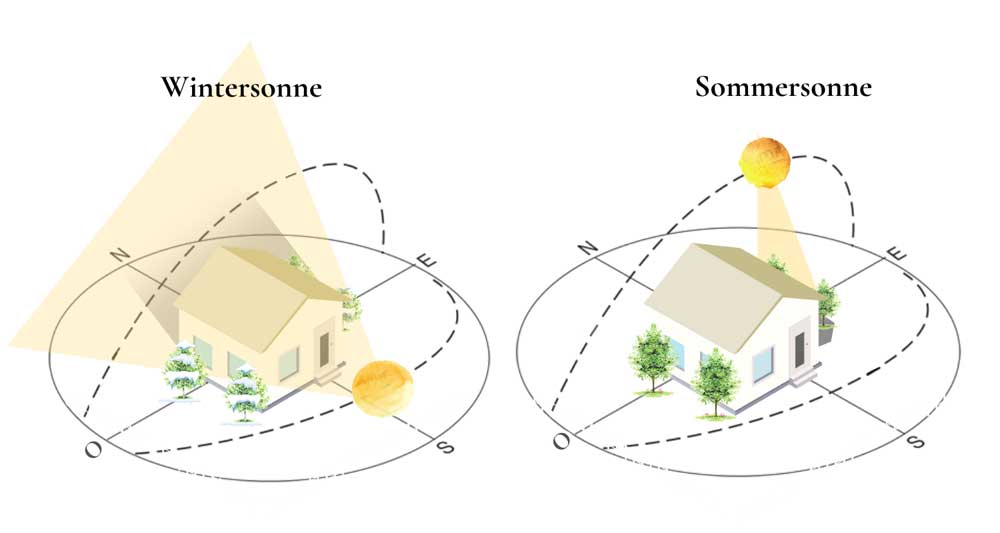How does a passive house work?
CASAL MALLORQUÍ is your partner for a sustainable and ecological house on Mallorca.
A passive house is a house that is designed and built so that it requires hardly any energy for heating or cooling
To achieve a comfortable temperature, passive houses consume 90% less energy annually than a conventional house. This eliminates the need for conventional heating and air conditioning systems, which consume a lot of electricity.
Great comfort and
sustainability
Why choose a passive house on Mallorca?
There are people who choose it because it is the most responsible and environmentally conscious building concept for our planet. But there is another crucial reason to choose to build a passive house on Mallorca: the comfort that you and your loved ones will experience when you live in the house.
Because it is a proven fact. Passive houses are much more comfortable and user-friendly than houses built according to traditional construction methods.
After all, that’s what we all want from a home that we can live in comfortably with our family, right? A comfortable home where we can enjoy every room.
A house where we can walk barefoot without feeling temperature changes when we stand near a window.
Living in
a passive house
The Passive House standard is the most effective application of physical principles to building.
The thousands of Passive Houses already built and in use around the world and the exponential growth of this building standard today are irrefutable proof of its effectiveness.
However, there is much more valuable evidence: the satisfaction of the inhabitants of this type of house and the reactions of those who live in a Passive House.
There is no doubt that the comfort achieved does not leave anyone indifferent.
Advantages of a passive house on Mallorca
Your life will change positively when you live in a passive house

Reduction of colds
By avoiding drafts and sudden temperature changes between different rooms of the house, the temperature is controlled much better than in a standard house. This reduces the risk of colds and flu for the whole family.

Calm improvement
The thick walls contribute to better sound insulation. Passive houses are quiet houses that prevent outside noises that cause stress and insomnia, Therefore, you will have a better rest and feel more optimistic and productive.

Good air treatment
The ventilation system with heat recovery replaces conventional heating and cooling systems and provides constant air exchange. The result is pure, clean air circulating throughout the house, maximizing comfort for anyone with respiratory problems or allrgies.

Time saving during construction
The construction time of your passive house can be significantly reduced if, instead of the traditional construction method, you choose a structure and a thermal wall layer made of wood, which is delivered to the construction site already prefabricated.

Permanent money saving
A passive house saves you money in the long run, as it reduces heating and cooling needs by 90%. In a standard house of 200 sqm, the normal consumption is about 3000 € /year. However, in a passive house this drops to 300 € /year, resulting in a saving of 2700 € /year.

Moisture avoidance
Conventional houses often suffer from moisture due to insufficient ventilation or thermal bridges. The airtightness of the construction of passive houses puts an end to condensation problems and keeps the dreaded moisture out.
Click on the dots and the inhabitants of a “passive house”
tell you something interesting about the house.
Imagine living in a house with a comfortable temperature all year round and almost no energy consumption.

It's like magic!
Passive houses require very little energy to heat up, as they only emit heat when it is needed. In many cases the residual heat emitted by an oven while cooking, a toaster, a computer, a light bulb or the sunlight itself is enough to warm them up. This fact amazes those entering a Passive House for the first time.Our electricity bill is very low
Passive houses have a primary energy requirement for heating and cooling of only 15 kWh/m² per year. These figures may not mean anything to you at first glance, but they are incredible when you consider that a conventional house consumes about 90% more. This characteristic of passive houses saves you a lot of money your electricity bill.Is it raining?
Passive houses are extremely quiet. Their superior soundproofing blocks outside noise so you won't even hear the raindrops falling. The insulation is so good that a passive house can even be built next to an airport without the occupants of the house hardly hearing the noise of the planes. No outside noise will disturb your rest. The absence of the usual sounds of traffic, construction, thunderstorms, neighbors, etc. will improve your family's night's sleep, mood and ability to concentrate.
They like to sit by the window and read
In winter it is usual in a house that, even in the same room, there are different temperatures: a colder one near the windows and the walls of the facade and a warmer one inside the room. Although we are not always aware of it, this difference leads to thermal discomfort among the residents of the house. Unlike traditional houses, passive houses maintain a minimal difference between the indoor temperature and the temperature of the outward-facing walls and windows. This allows you to use the spaces near external walls and windows as a reading or relaxation area.How long has it been since we dusted off?
One of the biggest advantages of passive houses - apart from their low energy consumption - is the indoor air quality in the houses. Not only are there no smells, but also no pollen, no CO2 concentrations and no accumulation of dust on the upholstery of sofas, furniture, curtains, etc. In a passive house, a microclimate is created maintained in an "aseptic" environment that is clean and free from contaminants, which improves the quality of life for residents, and especially for those suffering from asthma, allrgies or respiratory diseases.
The windows do not fog up
The passive house exchanges the entire volume of air in the house at least every 3 hours. This avoids the concentration of CO2, but also of water vapour, which can ultimately lead to humidity in the house. For this reason, passive house windows do not fog up like those of a traditional house. The house maintains optimal humidity for its occupants. And this is very important for your health, because at a relative humidity of more than 60%, dust mites, mold and bacteria multiply and moisture develops, which can even cause respiratory problems. If the relative humidity is below 40%, the mucous membranes of the residents become dry.How wonderful it feels to get out of the bath!
In a passive house, the same temperature is reached in all rooms. This prevents annoying temperature differences between rooms or when getting out of the shower. A passive house is always at the perfect temperature, so you can move about freely without feeling hot or cold.Let's practice yoga in front of the window!
A passive house has an optimal degree of airtightness. The stable temperature and absence of air currents and filtrations from the outside make any room in the house the ideal place to exercise, without the thermal discomfort to feel, which can sometimes cause a cold.How wonderful it always smells at home!
The ventilation system of passive houses constantly exchanges the air. This means that food smells or other disturbing smells, e.g. from rubbish or animals, are removed much earlier and harmful particles from cleaning agents, tobacco, paint, varnish, etc. are not inhaled by the residents.

We are little ovens.
As unbelievable as it may seem, a 20 m2 room in a passive house can be warmed up by the body heat of 4 occupants.Our house uses as much energy as a lightbulb.
In fact, passive houses are so energy efficient that they can maintain indoor comfort at a temperature of 21ºC with an energy consumption equivalent to that of a 65 watt light bulb. This means great energy independence for you and protects you against the erratic fluctuations in the electricity price on the market.Barefoot all year round.
allone who likes to walk barefoot through the house will find their ideal home in a passive house. The excellent insulation keeps the entire structure at a comfortable temperature, including the floor. So all you have to do is choose the right type of floor – preferably warm materials like wood – and you and your family can walk around barefoot all year round. Due to the pleasant temperature of the floor, it can also be used as an excellent playing area for children.A passive house cools and
consumes little energy
A passive house heats and cools “passively” and consumes almost no energy.
In winter, the house makes the most of weather conditions and efficiently benefits from the sun, internal heat sources and heat recovery from the ventilation system to warm up. In this way, a temperature of over 20° C is maintained.
In summer, passive cooling techniques, such as the strategic use of shaded areas or pre-cooling of the supply air, are used to keep it comfortably cool.
This ensures that a temperature below 25°C is maintained in summer, even when it is much warmer outside.

The 5 basic principles of a passive house
In our projects we follow the 5 basic principles of the German building code for a passive house:
The shell of a passive house must prevent the uncontrolled passage of air. For this reason, we pay great attention to its compactness during construction.
The building systems we use promote the formation of a continuous shell and minimize the conflict points where drafts or thermal bridges can occur.
This ensures that all sections are properly sealed, achieving optimal energy efficiency.
The window frames used are placed efficiently and strategically to get the most out of them. The windows and doors that we install in our projects are equipped with double or even triple glazing.
Their precise orientation allows the house to make better use of solar radiation (when the doors and windows are closed) and natural ventilation (when the windows are open).
In winter, solar radiation heats the house, while in summer passive cooling methods block this radiation to prevent overheating. All these measures provide a natural and comfortable indoor climate all year round.
A thermal bridge is a break or weakness in the insulating surface of the building envelope that protects the building.
This defect leads to the fact that heat is lost in winter or heat enters the house in summer. It can also lead to condensation, moisture or mold growth.
To avoid these problems, passive house constructions are carefully designed to ensure that all parts of the house are fully and durably sealed.
This avoids energy losses and the formation of condensation spots and achieves higher energy efficiency.
.
Thanks to the construction system used and especially the choice of insulation, thickness and continuity, we achieve exceptional energy efficiency and comfort.
Energy loss through facades, window frames, floors and roofs is minimal. The thickness of the insulation is double or even triple that of conventional houses.
By keeping the temperature close to 20º C even on the wall surfaces, thermal comfort for the occupants is guaranteed. It is this continuous insulation, which runs through the entire thermal envelope of the building, that prevents cold bridges or air infiltration.
The high quality of the insulation contributes to the achievement of the energy neutrality of the house, as the temperature can be better maintained and at the same time the noise pollution from the outside is avoided.
The mechanical ventilation system of passive houses is a crucial factor in maintaining the right temperature throughout the year.
Ventilation avoids moisture problems, which is very beneficial for the health of the inhabitants of the house. In addition, this system ensures the longevity of the building, preventing condensation, mold and so on.
The fact that you do not have to open the windows for ventilation is an advantage, especially in winter. In summer, you can ventilate at night to remove the heat accumulated during the day.
The operation is simple. On the one hand, the system uses filters that clean the incoming and outgoing air before it enters the house. On the other hand, depending on the season, the system provides heat exchange between the incoming and outgoing air to heat or cool the house.

How to live in a passive house in Mallorca?
No drafts from
windows or doors
windows or doors
No cold zones
in all rooms
in all rooms
No sudden
temperature differences
temperature differences
No noisy and expensive
heating and air conditioning systems
heating and air conditioning systems
South facing and
protection from the sun
Each house is designed to make optimum use of the special climatic and geographical conditions of its location
The orientation of a Passive House and the design of the facade openings are crucial for the (positive) energy balance.
Therefore, when building a Passive House on Mallorca, we look for the best sky orientation on the property, the prevailing wind direction, etc.
In a mild climate like Mallorca, the sun’s rays are more inclined in winter, while in summer they shine almost vertically. This means that the best orientation for a house in the northern hemisphere is south.
Therefore, we design the facades with large openings and glass surfaces facing south, which act as heat collectors and natural radiators in winter.

This orientation allows more sunlight to come through the windows in the winter, just when it is needed. In the summer, we should avoid an excess of sunlight by creating shaded areas such as porches,
Eaves, awnings and pergolas, or even creating shade from natural elements such as trees or vines. These shaded areas protect the house from the sun’s rays, keeping the house cool in the summer.
Frequently
asked questions
The answer is no.
It is important to distinguish between passive houses and passive houses that are passive house certified.
The Passive House Standard is the world’s most stringent and fastest growing energy efficiency certification. The secret of its success is quite simple: It keeps what it promises. Precisely for this reason, houses that want to bear this official seal of quality must meet the demanding criteria of the Passive House Institute.
This differentiation is important because the official certification guarantees that the house really meets the requirements for high energy efficiency. This means that certified houses have a higher market value have.
Casal Mallorquí specializes in the construction of passive houses, certified by the Passive House Institute, so we can build your house with official certification if you wish.
No, passive houses do not heat themselves.
But they are designed and built so that the insulation has the capacity to retain heat and not lose it.
This makes it possible to heat the houses with a minimal heat source. The same goes for cooling.
Passive Houses are heated or cooled with minimum energy costs, while retaining the greatest possible amount of heat or cold to achieve maximum comfort.
Of course you can open the windows.
But in practice this is usually not done because it is not necessary.
The mechanical ventilation system with heat recovery completely renews and cleans the air in the apartment in two to three hours.
The air that the occupants of the house finally breathe in is therefore of a higher quality than the outside air.
A passive house saves 90% of heating and cooling costs.
Over time, these savings outweigh the small additional construction costs.
It is common to recoup the additional construction costs before 10 years have elapsed. Although the cost of building a house depends on many factors (area, construction, qualities, number of rooms, etc.), the additional costs are between 5 and 10%.
However, we must make the distinction between price and value here. Even if the construction price of a passive house may be a bit higher from an economic point of view, it should be noted that living in a house with unparallled comfort is priceless in terms of quality of life.
The passive house standard has proven to be very efficient in both cold and hot climates.
Passive houses are equipped with a double ventilation system that makes it possible to cool the air in the room in a very simple way.
The fresh air brought in from outside at night flows directly into the house without being heated by the warm air from the house.
The result is an ideal temperature even during the hottest summer days in Mallorca.
Passive houses can be built with the same materials used in the construction of traditional houses (cement, concrete and steel), with materials of natural origin such as wood, or with a combination of both.
At Casal Mallorquí, we can respond to the individual requirements of builders who want to build their passive house with traditional materials or prefer a construction with an outer shell made of wood.
In both cases, the end result will be a comfortable house with perfect insulation that improves the well-being of its occupants, since the choice of one or the other material is not determinative of the style of the passive house or its energy efficiency.
If you choose to build a house with a timber shell and structure, the aesthetics will be in no way different from that of a passive house built with conventional materials.
However, not all options are equally environmentally friendly. In this sense, wood is undoubtedly the best option. We shouldn’t forget that wood is a 100% recyclable and sustainable material, so its use reduces our carbon footprint, which is not the case with other materials.
The most important thermal energy sources in Passive Houses are natural energy sources
such as the sun, household appliances, artificial light and body heat.
Factors such as the material and thickness of the walls or the insulation of the windows, floor and roof help maintain a constant temperature by preventing heat from being transferred from inside to outside in winter or vice versa in summer.
This is usually not necessary.
Passive Houses dissipate the heat in the house through certain mechanisms that help to cooland prevent overheating.
Some of these are the south orientation of the house, the use of vegetation and planning for external shading and sun protection such as pergolas, canopies, canopies, etc., which help to reduce the temperature inside the house by shading to reduce.
In addition, the insulation and placement of windows and doors should be planned in detail to minimize the use of air conditioning. Instead, cross-ventilation can be used at night during the summer months to maintain the optimal temperature in the apartment during the day.
From December 31, 2020, all newly built houses must be low-energy houses.
And soon the laws to protect the environment will become stricter and even apply to already built houses.
In Germany, Belgium and Austria there are even regions where it is mandatory to build public buildings according to this standard.
If you take the first step now and build the house of the future, you will save yourself the inconvenience of having to adapt your house to the new legislation in a few years’ time. It’s a chance to save yourself a lot of time, money and hassle.
Curious about how we build a passive house on Mallorca?
The best way to understand why a Passive House is built faster than a traditional house is by watching the following video of our project being built in Cala Murada.
Planning of the passive house
Building according to the specifications
Construction monitoring
Turnkey passive house
Video abspielen
Contact
us here
E-mail address:
info@casalmallorqui.com
Phone number:
+(34) 667 626 823